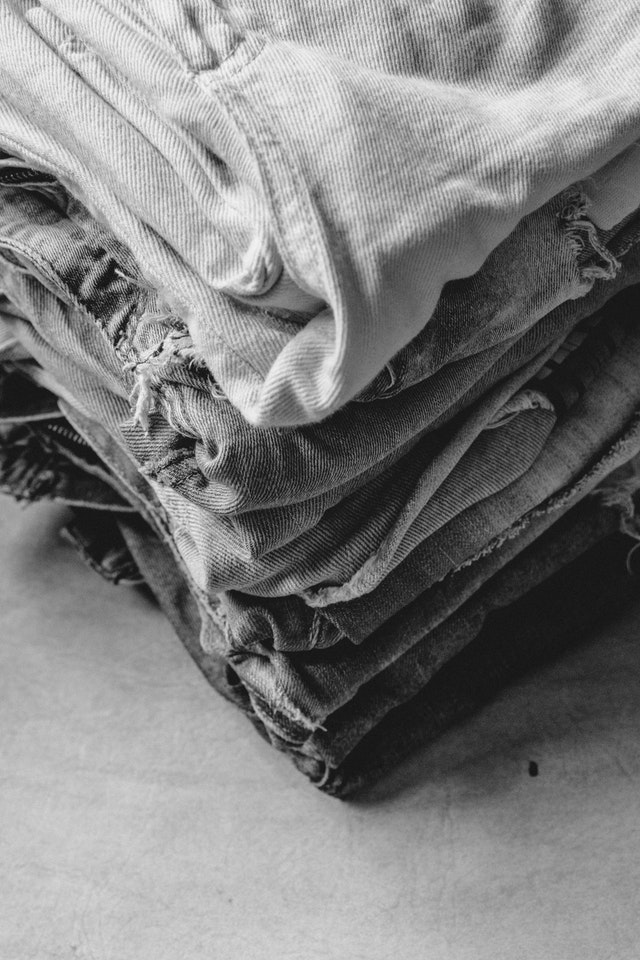Learning and Changing
I have long tried to make sustainable choices when making textile art but, I am ashamed to say, that has not always been the case. When I started quilting 20+ years ago, I began as many sewists doing – by accumulating a fabric stash. I began to acquire beautiful new 100% cotton, ith the understanding that natural cotton must be the best way to go.
It did not take long to learn that 100% cotton is not all created equal. Some feels softer or more textured or thicker. Some drapes much nicer or holds shape better or is more colour fast. It took longer to learn some of the less visible and arguably more important differences like the impact of manufacturing processes and practices.
I have changed how I acquire textile and the materials that I use. I now make art mostly with scraps, offcuts and upcycled materials from previously used clothes or other textile items. I never shop at box stores or national chains and support local shops for very occasional new fabric purposes. I use mainly materials that I have previously acquired or trade with other sewers. I try to be responsible about passing on materials that I will not use, find it a home where it will put to good use. Sometimes, I find bags of materials on my doorstep from friends who know that I will sort, process and use or rehome.
But I know that I can do better so I keep exploring options and researching suppliers.
Do the best you can until you know better.
Then when you know better, do better.Maya Angelou
My Goals for Textile Sustainablity
- Continue to reduce my textile use and to buy NO new textiles that are not ethically produced and sourced
- Use natural fibers, natural dyes, and as much locally sourced material as possible, and encourage other artists to do the same
- Advocate for companies to use practices that are environmentally and ethically responsible in the creation, distribution and life of textiles
- Learn more about textiles and their properties
- Make and mend more of my on clothes (eventually 100% of any new items)
How long it takes textiles to decompose
Slow Fashion
It is hard to think or talk about textile use without making a connection to the fashion industry, the main contributor to textile waste. The term slow fashion has become a counter to the idea of fast fashion, throw-away clothing.
How do you know if a company uses sustainable practices?
If you want to make responsible choices about fashion purchases, you need to know something about the companies selling fashion.
This article has good guidelines to assess different brands.
How to Check if a Brand is Sustainable: 7 Effective Tricks
The first recommendation is Understand what kind of ‘sustainable’ or ‘ethical’ you’re after
This is a question that often is not something that people think about when examining brands. Some considerations include:
-
-
- Clothes that have been produced in a way that’s kind t the environment (sustainable or eco-friendly)
- Vegan and free from animal by-products (ethical or vegan)
- Produced by garment workers who are paid good wages and treated with dignity (fair trade or ethical)
-
Of course, you might require all of these or some different combination. It is a question worth considering.
The other presented ‘tricks’ for evaluating sustainability are: Consider materials; Look for transparency; Check for third-party certifications; Take packaging and delivery into account whenever possible; and Do your research.
Note: This article is from Project Cece, a UK based company that offers a search engine for ethical clothing and sustainable fashion in Europe. They have a lot of informative and interesting articles.
Related terms
Slow fashion
The opposite of fast fashion, and an element of the slow movement that calls for responsible manufacturing practices and processes that demonstrate respect for the environment, people and animals. It typically emphasizes natural products, reuse and recycling, and shopping locally.
Deadstock Fabric
Surplus fabric from designers or clothing manufactures. Traditionally would be held for a season and then trashed. There is growing demand by fashion houses or fabric shops are that are ‘rescuing’ textiles destined for disposal and using it for manufacturing or resale. This keeps the surplus from landfills and can be an ideal opportunity for small or new sustainable companies to reduce their footprint, keep costs down and acquire limited and quality fabrics, including scraps that are often ideal for small clothing items or accessories.
Critics of deadstock fabric point out that it offers an incentive for manufactures to produce or buy more for the opportunity to sell and offset costs, rather than find incentive to reduce production and consumption. It also can be difficult to track fibers or manufacturing processes and practices. Some refer to deadstocking as greenwashing.
Greenwashing
A marketing tool used by companies to make it seem that they are more environmentally responsible than they actually are by using terms like sustainable, green, eco-friendly without evidence or definitions.
You can help reduce the impact of greenwashing in fashion by being informed.
Eco Friendly Options
Some ways to reduce your textile footprint and make a difference:
- Look for sustainable fibres (, sustainable practices and environmentally responsible brands.
- Become more informed about textiles and the processes and practices used to make them
- Learn more about the full life cycle of clothes and textiles and how to manage it
- Buy used, buy local, trade with friends or on local buy-nothing community sites
- Make your own clothes
- Do more mending
- Recycle, upcycle, reuse. Turn a pair of jeans into a skirt or a bag. Use old cotton shirts to make a memory quilt. Make a shirt from a dress – or vice versa.
Do you have other suggestions to reduce the footprint around textiles? Please share in the comments.
Be informed. Be creative. And join the movement to keep learning better AND doing better.
Banner photo by Pavel Danilyuk from Pexels
Textile photo by Paula Massimino from Pexels




Very helpful information! I too look for sustainable fabrics in our drapery business. As for my own clothing, I’m always looking for ways to re-cycle and upcycle. This is one way I can be creative and some are even a challenge which I love!
A very useful post.I like to recycle and upcycle my clothes and fabrics as much as possible.